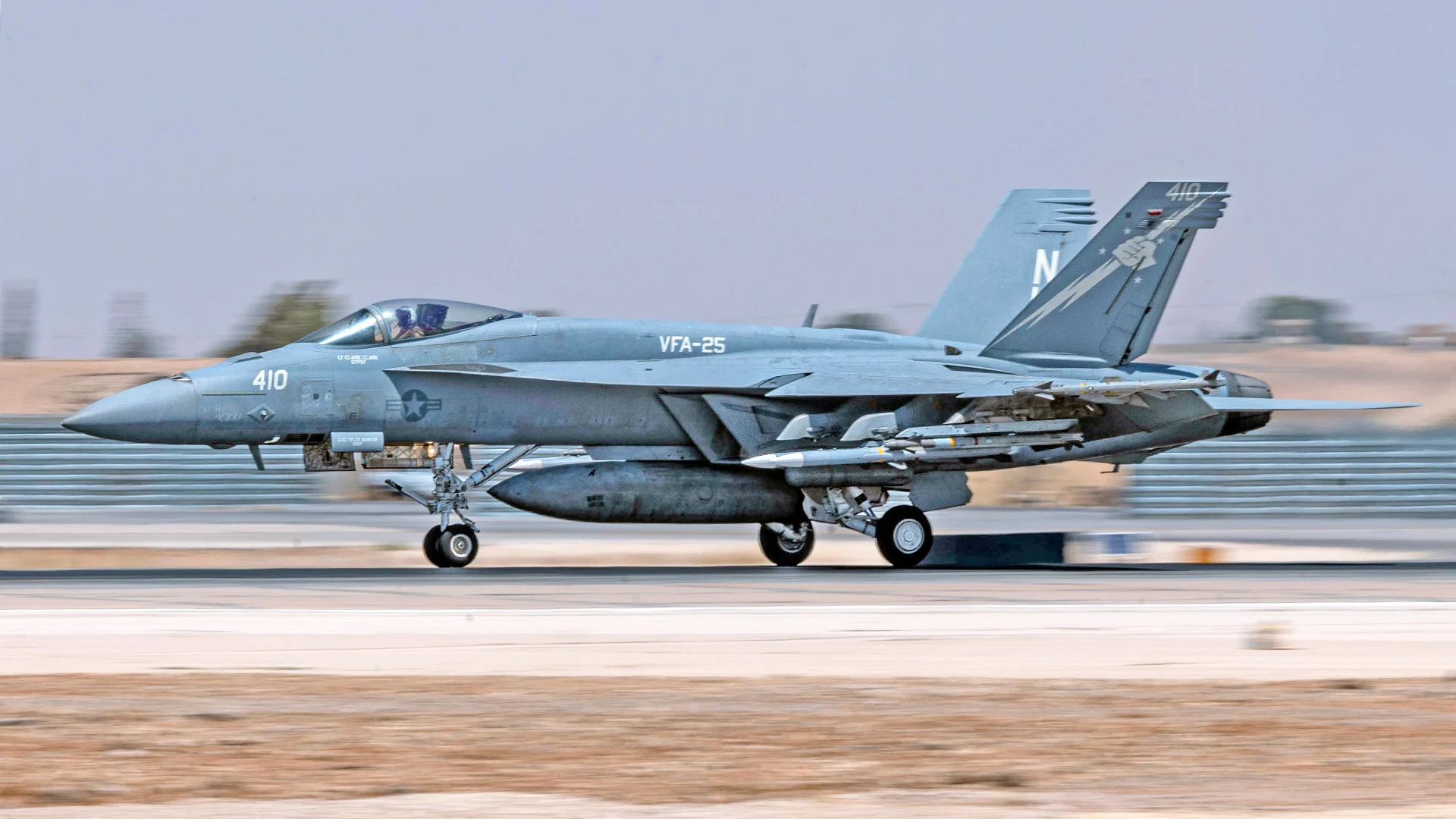US Navy F/A-18E Super Hornets brandishing full loads of nine air-to-air missiles have touched down at a base in Jordan ahead of expected Iranian attacks against Israel.
U.S. Navy F/A-18E Super Hornets from the supercarrier USS Theodore Roosevelt are now operating from a major U.S. air operations hub in Jordan. The fighters were photographed configured for counter-air operations, each brandishing at least four AIM-120 Advanced Medium-Range Air-to-Air Missiles (AMRAAM) and four AIM-9X Sidewinders, all live weapons.
They touched down ashore this past weekend as part of a U.S. military build-up in the region ahead of expected major attacks on Israel, and potentially U.S. interests, by Iran and its proxies. Iranian authorities have vowed to respond in a major way to the assassination of Hamas’ top political leader Ismail Haniyeh in Tehran last week. A series of long-range aerial attacks, using drones and missiles, is seen as the most likely course of action for Iran, hence the air-to-air configured Super Hornets forward deployment to Jordan to upgrade the region’s air defense posture.
The F/A-18Es from Strike Fighter Squadron 25 (VFA-25), the “Fist of the Fleet,” arrived at Muwaffaq Salti Air Base on August 3, but the U.S. Air Force only released pictures, one of which is seen below, showing them landing there yesterday. Reports that an unspecified Super Hornet squadron had left the Theodore Roosevelt for a base on land somewhere in the Middle East had also first emerged yesterday.
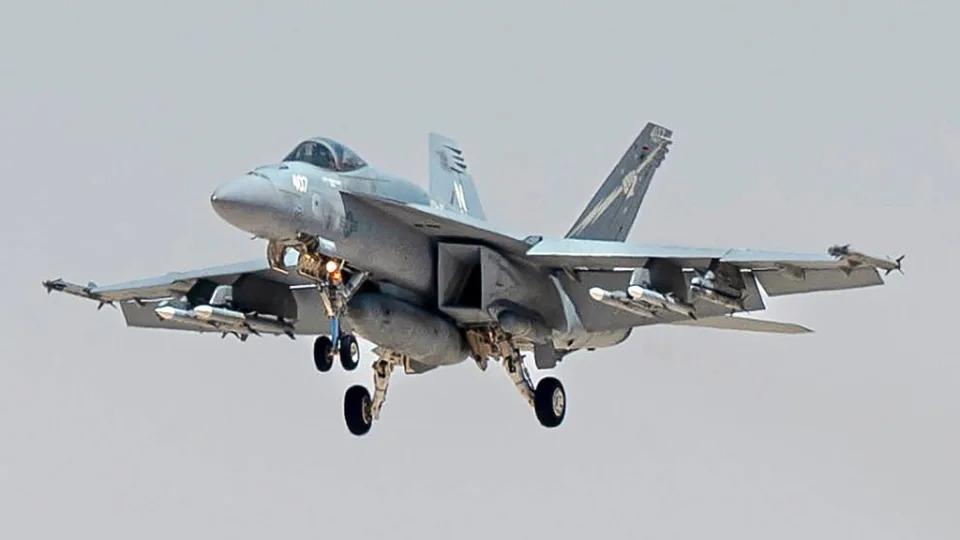
The newly released Air Force images do not explicitly name Muwaffaq Salti, but do mention the service’s 332nd Air Expeditionary Wing, which is known to manage U.S. air operations at the sprawling Jordanian base.
"undisclosed location" https://t.co/NI9ECYbdrf – US Navy VFA-25 F/A-18 Super Hornet at Azraq/Muwaffaq Salti Air Base, Jordan https://t.co/e9F9hd8ApQ pic.twitter.com/66wBnUxX1M
— Samir (@obretix) August 8, 2024
Positioning the Super Hornets at the Jordanian base in advance of any attack on Israel by Iran and/or its regional proxies makes good sense. Muwaffaq Salti is very centrally located in the region and has long been a key staging location for American air operations across the Middle East. Air Force F-15E Strike Eagles forward-deployed in Jordan played an outsized role in the defense of Israel against previous Iranian retaliatory attacks in April, shooting down more than 70 drones in total. Iran also launched cruise and ballistic missiles at Israeli targets in that instance.
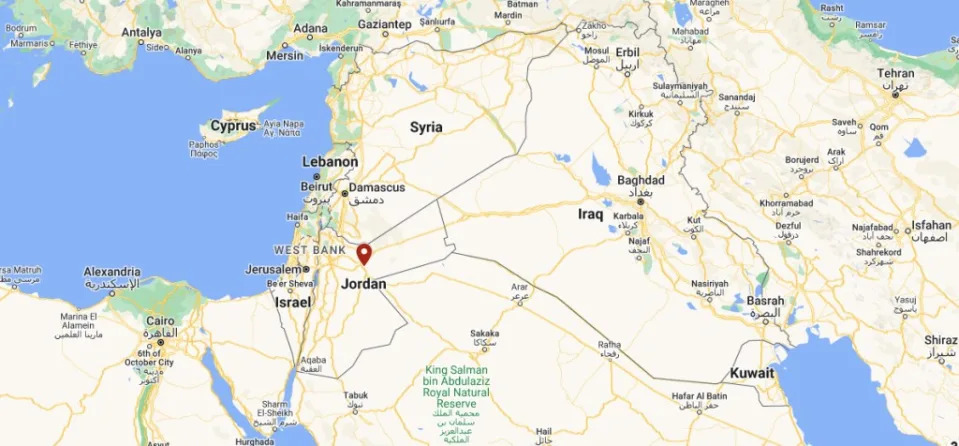
Just earlier this year, Navy Super Hornets became even better suited to help knock down hordes of incoming drones and cruise missiles. The service’s F/A-18E/Fs can now carry AIM-9Xs on their two most outboard underwing stations (stations 2 and 10) in addition to their wingtips thanks to a crash program in response to the still ongoing attacks on commercial shipping and warships in and around the Red Sea by Iranian-backed Houthi militants in Yemen.
The jets from VFA-25 that arrived at Muwaffaq Salti Air Base showcased this air-to-air munitions flexibility with four AIM-9Xs installed. As already noted, the fighters were also armed with at least four AIM-120s. It is likely that each of the jets carried a fifth AIM-120 on their right intake station, but this is not clearly visible in any of the released pictures. The nine-missile counter-air loadout, which is more air-to-air missiles than the F-15E can carry during a single sortie, has been observed in use in operations over and around the Red Sea.
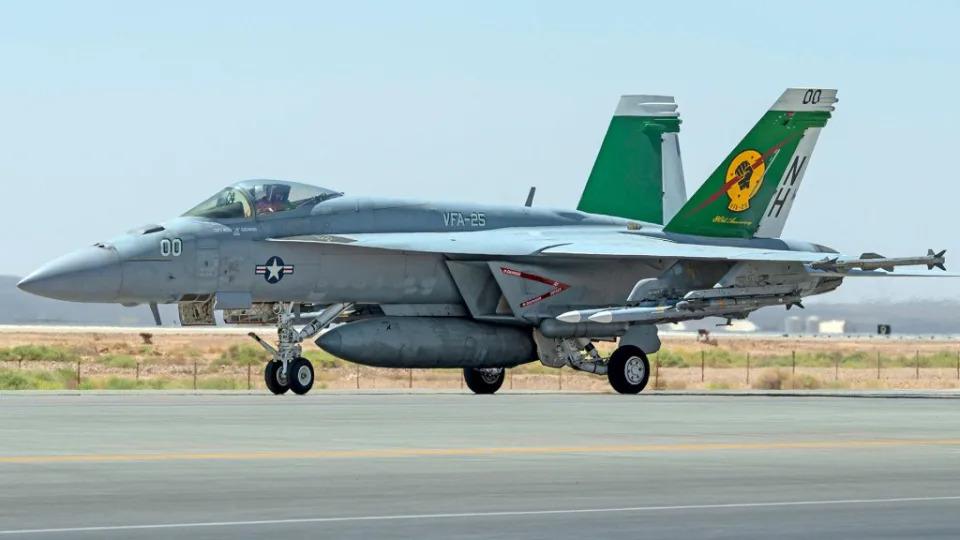
AN/ASQ-228 Advanced Targeting Forward-Looking Infrared (ATFLIR) targeting pods are visible on the Super Hornets’ left intake stations and each one is also carrying a 480-gallon fuel tank on the centerline. As The War Zone has previously noted:
“Potentially, another AMRAAM could be carried on the left intake station, for a total of 10 air-to-air missiles, although in this instance the station is loaded with the aforementioned ATFLIR pod. Advanced targeting pods are critical components of a modern tactical fighter’s air defense arsenal as they allow for beyond-visual-range positive identification of targets. This is especially important in densely populated and complex airspace, and can lead to quicker identification friend or foe and the ability to fire on a target with confidence long before it would be within the rules of engagement otherwise. ATFLIR’s infrared and TV sensors can be slaved to the Super Hornet’s radar and vice-versa, adding an extra layer of integrated targeting.”
“The pods can also collect important intelligence on aerial targets, whether they are engaged or not. A secondary quasi-infrared search and track mode is also available on some pods that can provide detection of stealthy targets, although this is not nearly as capable as a dedicated advanced IRST sensor system.”

It’s not entirely clear, but the VFA-25 Super Hornets now forward-deployed in Jordan may also be in the latest Block III configuration. The jets seen in the release pictures have a new conformal satellite communications antenna, also found on EA-18G Growler electronic warfare jets, on top of the rear end of their fuselage. Though not technically part of the Block III upgrade package, the Navy rolled this and other updates into a single larger modification process for existing Block II jets. New production Block IIIs have this feature, as well.

Block III Super Hornets feature new wide-area touchscreen multifunction displays that are highly customizable in their cockpits (including for backseaters in two-seat F models), along with improved mission computers with greater processing power and advanced networking capabilities. Another component of the upgrade package is still largely unexplained features to help reduce the jet’s radar signature to some degree. The original plan was to add range-extending conformal fuel tanks, too, but this was ultimately nixed due to issues encountered during the integration process.
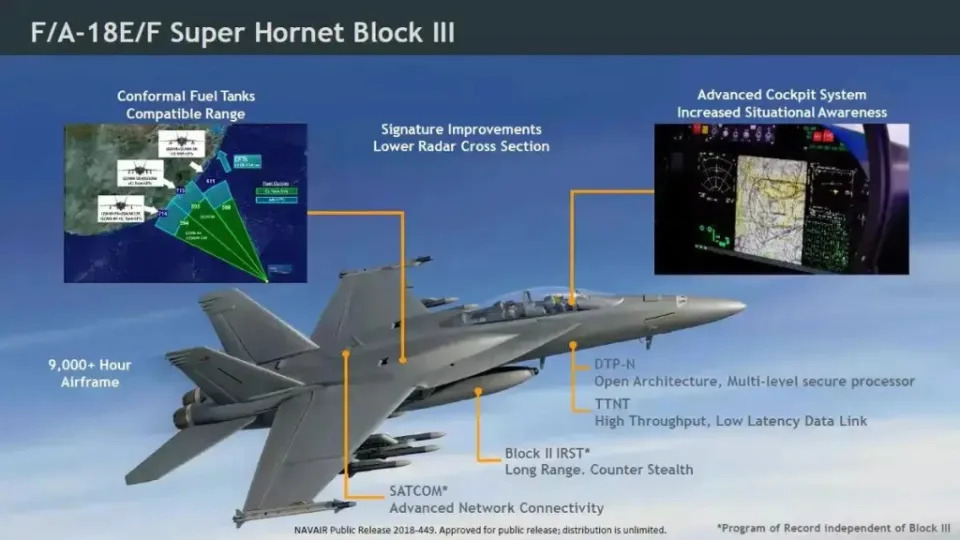
Improved communications and data-sharing capabilities would be invaluable for Super Hornets engaged in a response to any forthcoming Iranian drone and missile attacks, or a larger regional confrontation that might subsequently erupt. Assets from across the U.S. military in all domains, as well as other international partners, help shield Israel from incoming threats back in April, and close coordination in such operations is absolutely critical.
The War Zone just recently highlighted the very important roles that Navy E-2D Advanced Hawkeye airborne early warning and control aircraft, especially ones now capable of refueling in flight and staying on station longer, could soon play in the region for exactly these reasons. The look-down capabilities of the E-2D’s radar also make it well-suited to spotting and tracking low-flying, small signature drones and cruise missiles. Super Hornets and Advanced Hawkeyes are a particularly capable combination thanks to intricate networking architecture that allows for the former to engage targets that their radars and other sensors cannot ‘see.’
A @USNavy E-2D refuels inflight from an @usairforce HC-130 over the U.S. Central Command area of responsibility. pic.twitter.com/pRkmM4IRIP
— U.S. Central Command (@CENTCOM) August 6, 2024
The VFA-25 Super Hornets now at Muwaffaq Salti are just some of the U.S. military assets that have been heading to the region to help bolster America’s force posture in advance of any Iranian or Iranian-backed attacks. This also includes the amphibious assault ship USS Wasp and the other ships its amphibious ready group, along with the elements of the 24th Marine Expeditionary Unit embarked on those vessels, which are now in the Eastern Mediterranean Sea. The carrier USS Abraham Lincoln and its strike group are heading west from the Pacific, ostensibly to relieve Theodore Roosevelt. Among other things, Lincoln is carrying EA-18Gs with powerful new electronic warfare pods.
A dozen Air Force F-22 Raptor stealth fighters, having flown all the way from Alaska with a stopover in England, are among the air assets that have been dispatched to bases in the Middle East, as well. America’s force posture in the Middle East has already been bolstered multiple times since Hamas launched its unprecedented terrorist attacks on southern Israel on October 7, 2023, kicking off a chain of events that has led to the current situation.
U.S. Air Force F-22 Raptors arrived in the U.S. Central Command area of responsibility Aug. 8 as part of U.S. force posture changes in the region to mitigate the possibility of regional escalation by Iran or its proxies. pic.twitter.com/BuuzbUHu9s
— U.S. Central Command (@CENTCOM) August 8, 2024
The U.S. military has another potent addition to this force mix with the Navy F/A-18Es and their impressive air-to-air loadouts now at Muwaffaq Salti Air Base in Jordan.
AfriPrime App link: FREE to download...
https://www.amazon.com/Africircle-AfriPrime/dp/B0D2M3F2JT
There’s a Big Reason Things Haven’t Escalated Between Iran and Israel Yet
A week and a day have passed since an Israeli bomb killed Hamas’ political leader, Ismail Haniyeh, as he lay sleeping in an Iranian government guesthouse in Tehran. Soon after, Ayatollah Ali Khameini vowed “harsh punishment” against Israel, declaring it his “duty” to “avenge” the martyr’s blood.
Yet at least so far, nothing has happened. There’s a simmering tension between conflicting pressures—at once political, diplomatic, pragmatic, and ideological—to escalate the conflict or to cool it down.
It is a widely held view that Iran has to take some action in response. The killing took place on Iranian territory. Haniyeh had just attended the inauguration of Iran’s new president, as had leaders from Iran’s other allies—members of the “axis of resistance”—who must have wondered, in the wake of the attack, how capable Tehran would be at protecting them.
U.S. diplomats have called all their intermediaries with Tehran, urging that the ayatollah—the country’s real decisionmaker (he isn’t called the Supreme Leader for nothing)—keep any armed response restricted to military targets, not many, and to avoid killing Israeli citizens.
Israeli Prime Minister Benjamin Netanyahu has warned that if Iran did kill any civilians, he would strike back “disproportionately.” Some have hinted that Israel would respond by destroying Iran’s nuclear facility—a mission Israeli missiles and fighter jets have the range and firepower to accomplish and that, in fact, its crews have rehearsed.
President Joe Biden’s national security spokesman, John Kirby, has said that the United States would help defend Israel from any Iranian attack. In April, U.S., British, French, and Jordanian air-defense crews helped Israel repel a massive, multipronged Iranian attack—consisting of more than 300 missiles and drones, including 110 ballistic missiles—shooting down almost all of the projectiles that didn’t crash along the way.
However, there are a few new wrinkles in this buildup to a possible attack. On the one hand, Jordan’s leaders, who were heavily criticized by their Palestinian citizens for helping out Israel four months ago, say that if Iran mounts an attack this time, they won’t allow Israel or its defenders to use Jordanian air space—meaning Iran’s missiles and drones would have to be intercepted over Israeli territory, making it much harder to shoot down all of them.
On the other hand, Iran International, a U.K.-based news agency, reported that the new Iranian president, Masoud Pezeshkian, asked Khameini to refrain from attacking Israel, warning that an Israeli counterstrike could have dire economic consequences for Iran.
This news agency is of uneven reliability, so who knows if the story is true. However, the new president, who is a surgeon and former reformist politician, is relatively moderate. He ran for office, and won, on a platform of reengaging with the West. He has appointed Mohammad Javad Zarif, who was foreign minister when Iran signed the nuclear deal with the U.S. and five other Western nations, as his vice president for strategic affairs. He has also named Ali Bagheri Kani, Iran’s chief negotiator on the nuclear deal, as his foreign minister.
In other words, whether or not the Iran International story is true, it is plausible that the new president would be lobbying for a light response to Israel’s killing. It is not clear, though, how much influence he has over the Supreme Leader.
Another report (again of unknown reliability) suggests that Iran might respond with moderation, if at all, because it is now clear—this part is absolutely certain—that Haniyeh was killed by a remote-control bomb that was placed under the bed in the guesthouse where he usually stays at least two months ago by an officer with the Revolutionary Guard Corps—Iran’s elite service—who had been recruited by Israel’s Mossad. In other words, Iran’s own lax security was partly responsible for the assassination.
Finally, there is another angle to consider: Hezbollah, the Iran-backed militia that controls southern Lebanon, might go rogue. The group and Israeli forces have lobbed rockets back and forth for many years. The lobbing intensified, in frequency and explosive power, after Hamas’ murderous invasion of Israel on Oct. 7 and the ensuing war in Gaza. (Many have speculated that Hamas’ leaders expected Hezbollah to join in, attacking Israel from the north as they assaulted from the south. They were overly optimistic.) Last month, a Hezbollah rocket hit a soccer field in the Israel-controlled Golan Heights, killing 12 children. Israel retaliated with an airstrike in Beirut, killing Fouad Shukur, Hezbollah’s top military commander. (This occurred just hours before the assassination of the Hamas chief in Tehran. Few voiced outrage over the former; many, including Israeli officers, feared the latter might have crossed some line of provocation.)
With all this in mind, some—in the U.S., Israel, elsewhere in the Middle East, possibly even in Iran—worry that Hezbollah might step up its rocket attacks on its own, without authorization from the mullahs in Tehran.
Meanwhile, the fact that Iran hasn’t struck back eight days after Haniyeh’s killing is not necessarily a sign of restraint. Iran’s massive missile and drone strike against Israel earlier this year took place on April 13. That was 12 days after an Israeli airstrike on Iran’s consulate in Syria that killed seven senior officers of the Revolutionary Guard Corps.
It could be the Iranians are still plotting their next move. And so, we all wait.
AfriPrime App link: FREE to download...



